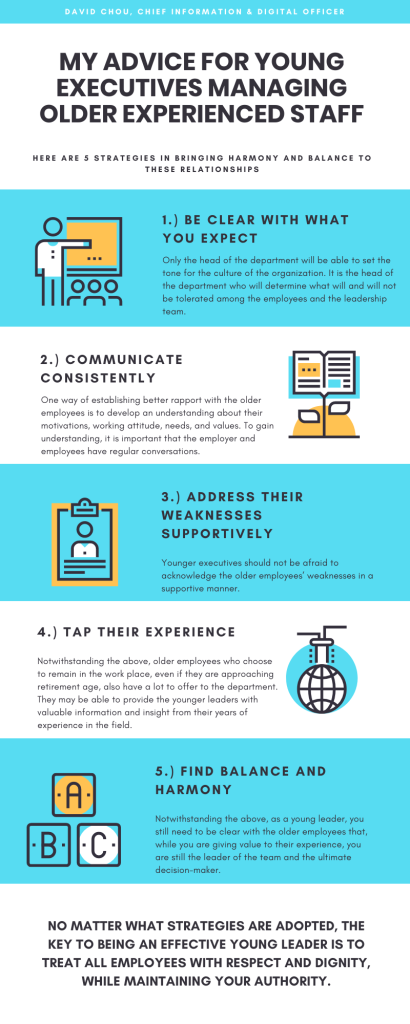My Advice For Young Executives Managing Older Experienced Staff
These days, it is not uncommon to see fresher and younger talents tackle management positions and working together with the more experienced and older colleagues. The number of executives that hold high corporate ranks while still in their 20s-30s has impressively grown through the years, despite the fact that seniority is generally a determining factor for promotion opportunities. This shifting corporate culture may bring about many different challenges to organizations, since younger CEOs and executives may struggle with supervising their employees, who are 10-20 years their senior. These older employees could feel discomfited when reporting to their younger employers and having to take directions from them. Nonetheless, there are several strategies that I have used in these situations, which may assist in bringing harmony and balance to these relationships.

Be clear with what you expect
Only the head of the department will be able to set the tone for the culture of the organization. It is the head of the department who will determine what will and will not be tolerated among the employees and the leadership team. As a young leader, whether you are the CEO, CIO, COO, CXO, or any other head of the department, you must be clear with the expectation and directions. Act like the leader of the department or of your team and communicate as much as possible to avoid any ambiguity.
Communicate consistently
One way of establishing better rapport with the older employees is to develop an understanding about their motivations, working attitude, needs, and values. To gain understanding, it is important that the employer and employees have regular conversations. A clear understanding of the employees’ motivations is critical for you to develop the organizational strategy. Your management strategy for an employee who is two years away from retiring is going to be a whole lot different from that for an employee who still has another ten or more years ahead of them before retirement.
However, as the head of the department, I believe that it is important to put the organization as a whole first before individual team members. In this regard, you should still strive to do what is best for both parties and always sympathize with the employee by putting yourself in their shoes and treating them the same way that you would like to be treated if the situation was reversed.
Address their weaknesses supportively
Younger executives should not be afraid to acknowledge the older employees’ weaknesses in a supportive manner. While it may be a widespread belief that older employees are likely to resist learning new things and are less likely to succeed in the digital era, I believe that this is a misconception. From my experience, there are actually a number of older workers who are more than eager to embrace new technologies. You will be able to encourage and assist such older employees to adapt to the new digital generation and be more comfortable with the technological changes by supporting them through use of manual demonstrations, tutorials, and various training programs. Give these employees the benefit of the doubt and be patient, while assisting and insisting upon their endeavor to engage in learning and applying new technologies in this digital era. The experience must be a positive one to motivate any individual to change.
Tap their experience
Notwithstanding the above, older employees who choose to remain in the work place, even if they are approaching retirement age, also have a lot to offer to the department. They may be able to provide the younger leaders with valuable information and insight from their years of experience in the field. Having their experience tapped through executive mentoring in which the older colleagues are offering guidance and advice on certain cases could help you shape better strategies. Everyone has a story to tell and a lesson to teach that may be valuable for any leader, young or old. In turn, this form of communication could make the older employees feel appreciated and motivated.
Find balance and harmony
Notwithstanding the above, as a young leader, you still need to be clear with the older employees that, while you are giving value to their experience, you are still the leader of the team and the ultimate decision-maker. This requires a delicate balance between strength and sensitivity – specifically, a balance between being a strong leader and a sensitive mentor.
There are many approaches younger leaders can take to work well and successfully with older employees in a department. Some of these approaches have already been enumerated above. However, no matter what strategies are adopted, the key to being an effective young leader is to treat all employees with respect and dignity, while maintaining your authority. This way you will be able to ensure balance and harmony in your department, which will result in a strong work culture and successful operations in the business.
This post originally appeared on David Chou’s LinkedIn Pulse.
DAVID CHOU
Chief Information & Digital Officer
CHILDREN’S MERCY KANSAS CITY
David Chou is the Chief Information & Digital Officer for Children’s Mercy Kansas City. Prior to Children’s Mercy David held the CIO position at University of Mississippi Medical Center, the state’s only academic health science center. David also served as senior director of IT operations at Cleveland Clinic Abu Dhabi and CIO at AHMC Healthcare in California. David is one of the most mentioned CIOs on social media, and is an active member of both CHIME and HIMSS.
Show Your Support
Access the report
Want to keep reading? Subscribers get exclusive access to DHI's extensive library of content, covering top-of-mind issues and trends for today's healthcare executive.
